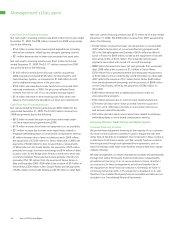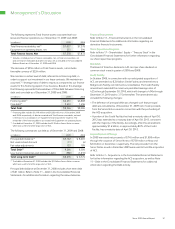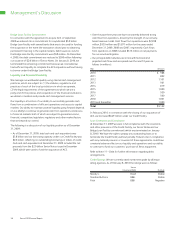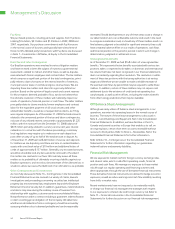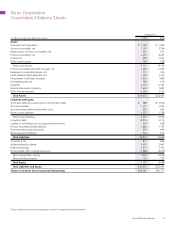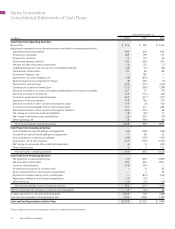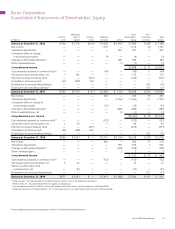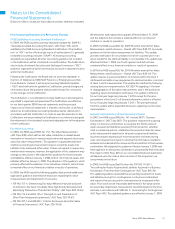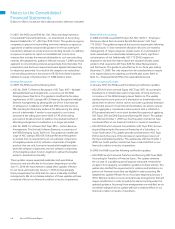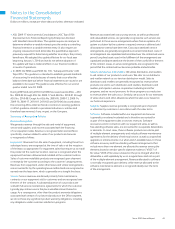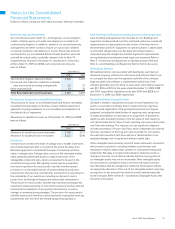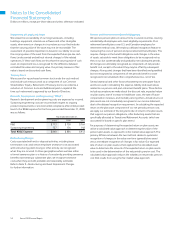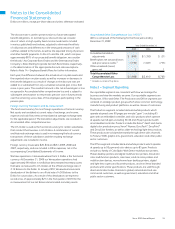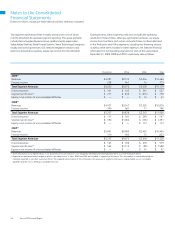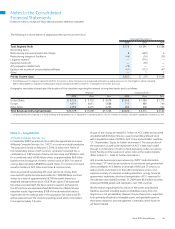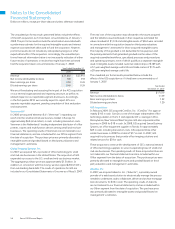Xerox 2009 Annual Report Download - page 48
Download and view the complete annual report
Please find page 48 of the 2009 Xerox annual report below. You can navigate through the pages in the report by either clicking on the pages listed below, or by using the keyword search tool below to find specific information within the annual report.
46 Xerox 2009 Annual Report
Notes to the Consolidated
Financial Statements
Dollars in millions, except per-share data and unless otherwise indicated.
Note 1 – Summary of Significant Accounting Policies
References herein to “we,” “us,” “our,” the “Company” and Xerox refer
to Xerox Corporation and its consolidated subsidiaries unless the context
specifically requires otherwise.
Description of Business and Basis of Presentation
We are a technology and services enterprise and a leader in the
global document market. We develop, manufacture, market, service
and finance a complete range of document equipment, software,
solutions and services.
Basis of Consolidation
The Consolidated Financial Statements include the accounts of
Xerox Corporation and all of our controlled subsidiary companies.
All significant intercompany accounts and transactions have been
eliminated. Investments in business entities in which we do not have
control, but we have the ability to exercise significant influence over
operating and financial policies (generally 20% to 50% ownership),
are accounted for using the equity method of accounting. Operating
results of acquired businesses are included in the Consolidated
Statements of Income from the date of acquisition.
We consolidate variable interest entities if we are deemed to be the
primary beneficiary of the entity. Operating results for variable interest
entities in which we are determined to be the primary beneficiary are
included in the Consolidated Statements of Income from the date such
determination is made.
For convenience and ease of reference, we refer to the financial
statement caption “Income (Loss) before Income Taxes and Equity
Income” as “Pre-tax Income” or “Pre-tax Loss” throughout the Notes
to the Consolidated Financial Statements.
In 2009, we changed the presentation of our financial statements
for noncontrolling (minority) interests. Refer to “Business Combinations
and Noncontrolling Interests” below for additional information.
Use of Estimates
The preparation of our Consolidated Financial Statements, in
accordance with accounting principles generally accepted in the United
States of America, requires that we make estimates and assumptions
that affect the reported amounts of assets and liabilities, as well as the
disclosure of contingent assets and liabilities at the date of the financial
statements, and the reported amounts of revenues and expenses during
the reporting period. Significant estimates and assumptions are used
for, but not limited to: (i) allocation of revenues and fair values in leases
and other multiple-element arrangements; (ii) accounting for residual
values; (iii) economic lives of leased assets; (iv) allowance for doubtful
accounts; (v) inventory valuation; (vi) restructuring and related charges;
(vii) asset impairments; (viii) depreciable lives of assets; (ix) useful lives
of intangible assets; (x) pension and post-retirement benefit plans; (xi)
income tax reserves and valuation allowances; and (xii) contingency and
litigation reserves. Future events and their effects cannot be predicted
with certainty; accordingly, our accounting estimates require the exercise
of judgment. The accounting estimates used in the preparation of our
Consolidated Financial Statements will change as new events occur, as
more experience is acquired, as additional information is obtained and
as our operating environment changes. Actual results could differ from
those estimates.
The following table summarizes certain significant charges that require
management estimates:
Year Ended December 31,
2009 2008 2007
Restructuring provisions and
asset impairments $ (8) $ 429 $ (6)
Amortization of acquired
intangible assets(1) 64 58 46
Provisions for receivables 289 199 131
Provisions for obsolete and
excess inventory 52 115 66
Provisions for litigation and
regulatory matters 9 781 (6)
Depreciation and obsolescence
of equipment on operating leases 329 298 269
Depreciation of buildings
and equipment 247 257 262
Amortization of internal use
and product software 58 56 79
Defined pension benefits –
net periodic benefit cost 232 174 235
Other post-retirement benefits –
net periodic benefit cost 26 77 102
Deferred tax asset valuation
allowance provisions (11) 17 14
(1) Note: this includes amortization of $4 for patents which is included in cost of sales.
Changes in Estimates
In the ordinary course of accounting for items discussed above, we
make changes in estimates as appropriate and as we become aware
of circumstances surrounding those estimates. Such changes and
refinements in estimation methodologies are reflected in reported
results of operations in the period in which the changes are made and,
if material, their effects are disclosed in the Notes to the Consolidated
Financial Statements.


